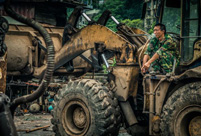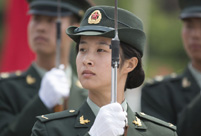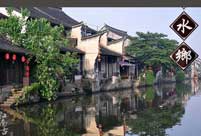 Chinese Kung Fu charms Silicon Valley
Chinese Kung Fu charms Silicon Valley
 Tranquil Yankou ancient town
Tranquil Yankou ancient town
 Lake Geneva: A show of swans
Lake Geneva: A show of swans
 Beautiful sunset over the Irtysh River
Beautiful sunset over the Irtysh River
 Qingjing Mosque: Witness of the ancient Maritime Silk Road
Qingjing Mosque: Witness of the ancient Maritime Silk Road
 Neiliansheng – more than 100 years of fashion
Neiliansheng – more than 100 years of fashion
 Golden retriever feeds baby African lions
Golden retriever feeds baby African lions
 Strange rocks in Lama Mountain
Strange rocks in Lama Mountain
 First overseas "China-standard" electric railway laid
First overseas "China-standard" electric railway laid
 College graduate launches organic agricultural cooperative in hometown
College graduate launches organic agricultural cooperative in hometownLofty Potala Palace, famous Barkhor Street, endless grassland, clean and pure lakes, old legends, mysterious and wonderful religious culture…
When the Tibetan traditional culture of thousands of years crashes into the modern civilization, where is the cultural direction of Lhasa?
In recent years, under the big background of constructing the Chinese featured cultural protection site and building up the world tourist destination, Lhasa greatly carries out the“Prospering City by Culture” strategy. Firstly, Lhasa insists on the heritance and development of traditional historic culture. Secondly, Lhasa promotes a new pattern for the prosperity of cultural business and the development of cultural industry.
Looking over changing and unchanging items, a delighted feeling arises spontaneously when we enjoy the historic travel and the modern era.
Retain the “living” ancient city culture
Tibetans and numerous domestic and foreign tourists have a “love knot of Barkhor Street” more or less no matter whether they have a sufficient understanding of culture and history.
Now, when you walk on the quiet Barkhor Street, complete details including numerous Tibetan-style buildings, elaborate Tibetan-style windows, old wooden maps, capacious and comfortable prayer roads, and unique street lamps indicate the changing and unchanging items of the ancient city protection: “ancient”, but not away from the modern world; “new”, but not get rid of tradition.
In fact, some years earlier, a part of streets in old district of Lhasa were regarded as “forgotten corner” jokingly. Along with the era development, social progress, and quickly expanding residents, a series of problems in the old district with a total area of about 1.33 square kilometers and permanent resident population of more than 100000 were criticized including: municipal infrastructures greatly behind the time; unsmooth traffic; aging electric power circuit; fire-fighting equipment behind the time; incomplete water supply and drainage facilities. Meanwhile, the protection for precious cultural relics and historic buildings in the old district was also of great hidden danger and troubled people due to erosion of wind and rain and ages.
By the end of 2011, on the 5th meeting of the 9th National Peoples’ Congress in Lhasa, 5 old representatives over 60 years including Yu Zhen together reflected problems including old water and electric pipeline, backward domestic installations, and hardship in resident life of old district in Lhasa. Entrusted by residents of the old district, they strongly demanded the quick launching of relevant transformation project in old district of Lhasa. As was expected, the news that Lhasa municipal party committee and Lhasa municipal government determined to carry out old district protection project was warmly responded and positively supported by residents of the old district.
In December 2012, the old district protection project was officially started in Lhasa. The project’s total investment was RMB1.5 billion. Qi Zhala, the Municipal Party Secretary of Lhasa, said, “the old district protection project shall firstly satisfy the demands of three levels: the first is the survival demand; the second is the cultural demand; the third is the spiritual demand.” For residents in the old district, the survival or life demand was the most important. However, people out of the old district paid greater attention to cultural demand and spiritual demand. “Satisfy the demands of three levels and give greatest humanistic care and more humanistic life enjoyment to residents in old district.” This is the solemn promise that Lhasa municipal government made for the old district protection project.
Ancient city protection not only changes the elements in modern life, but also changes the new thought of heritance direction: the exhibition hall of the old site of grand minister resident of Tibet during Qing Dynasty and Dge-vdun-chos-vphel Memorial Hall are the important classroom that cadres and people of all nationalities study the history, know the reality, and distinguish right from wrong; the hotels of old buildings with courtyards for lodging and catering including Yaoxipingkang and Bangdacang facilitate tourists to be lost in the strong Tibetan culture; residents in the courtyard including Jiayang and Muruningba deeply retain the “living” folk culture of Tibet…
The ancient city just wants such a classic and powerful splendidness.
Culture benefiting and warming the people
“Tibetans can sing when they can talk, and can dance when they can walk.” This is people’s praise for Tibetans because they are skilled in singing and dancing.
At 8:00 p.m. of the beginning of summer in Lhasa, the sun still shines on the sky. People begin their “night life” in Potala Palace, Zongjiaolukang Park, Norbulingka Park, and various communities: they dance along with the music in a powerful way or soft way.
This Happy Lhasa Standardization Dance popular with the citizens and tourists from February of 2012 is just an epitome that Lhasa guarantees and improves “cultural livelihood”.
Careful people will find that the public cultural service system in Lhasa becomes more and more complete while people’s cultural life becomes more and more abundant. However, what is unchanged is the determination that Lhasa insists on “culture benefiting and catering to people.”
- According to the requirements of public benefits, basic, equality, and convenience, led by the government and involved with public benefit cultural units; Lhasa makes efforts to construct the public cultural service system covering the city and the countryside with a focus on public cultural facilities. A new pattern of four-level public cultural service system featured by “networked facilities, diversified supply, long-acting mechanism, city and countryside integration, and popularized services” based on municipal mass art centers and songs and dance troupes, and supported by county (district) comprehensive cultural activity centers and village and town comprehensive cultural sites basically takes shape. Meanwhile, municipal mass art centers and county (district) cultural centers are open for free with “no threshold”. Furthermore, all counties have folk art troupe. In 2013, the total investment amount for cultural infrastructures in the whole city reached RMB60.4405 million while the investment of RMB43.478 million was completed.
- Lhasa greatly carries out the core value education activities themed by “Patriotism, unification, harmony, development, and civilization” and Thanks for Party Love Thematic Education Activities (“Eight Look, One Accounting, One Disclosure, Four Enhancement”). The entry of advanced cultures in temples is steadily promoted. In the whole region, Lhasa is the first that realizes the complete coverage of president’s figure, national flag, newspaper, radio and television, film, and temple book. Based on the opportunities of cultural performance activities including key festivals, cultural and technical “Five for Countryside”, “Millions of Serfs Liberation Memorial Day”, “Four into Community”, “Construction and Protection Jointly by the Army and the People”, “Strive for Best Benefiting People Activity”, Moral Model “Good Person Beside” Basic Layer Tour Show, and Wangguo Festival, the cultural feasts are sent to the schools, village residences, communities, temples, and village work team. According to the incomplete statistics, more than 700 performances are given, benefiting for more than 250000 audiences.
- Numerous high-quality shows on the splendid stage. In 2013, Fairy Zhuowa Sangmu won the Star Award of the 8th China Art Contest. Fairy Zhuowa Sangmu, the traditional Tibetan opera, won Star Award, the highest governmental award of National Mass Culture. A Xie won the Golden Award of 7th TV Dance Contest. Aga Dance won the Golden Award of National Skill Competition. “Zhigonggajujinjinbaochuan Thangka”, the intangible cultural heritage, passed the authentication of Guinness World Records and won the title of “World Biggest Thangka”. Lhasa also obtained numerous awards from various competitions in the autonomous region. These works with great ideological level and artistic level further promote the soft cultural strength of Lhasa.
- Citizens, who have an increasingly abundant material life, enjoy more and more colorful cultural life in this changing and unchanging city.
Cultural industry promotes the development
When Lhasa becomes increasingly prosperous, Cijiaolin Village, only on the other riverbank of the city, keeps unchanging. The small village is always featured by its quietness and peace. It is said that Cijiaolin Village is the gathering place for entourages of Wen Cheng Princess in Tibet.
In 2013, a big live-action opera, Wen Cheng Princess, was shown here, which added a great fire to the hot tourist market. In three months, the opera was shown by 82 times in total, attracting more than 70000 audiences.
The real “changing” items must be based on the “unchanging” items.
Just as the commercial performance of Wen Cheng Princess, a series of famous festival fairs, cultural activities, and industrial brands in the region and even in China including Tibetan New Year, Lhasa Sho Dun Festival, “Tunmiling • Tibetan Art Museology Park” are created by Lhasa based on its historic and cultural advantages in recent years. Because of this, Lhasa won Global Festival City Award last year and obtained “double harvests” in social and economic benefits.
The deep integration of culture and tourism is benefited from the trend that cultural industry is now becoming “the top leadership project”. Namely, “the economy supported by culture” is the old trend. Now, the culture is supported by city. Currently, there are more than 1000 various cultural operation companies.
However, all of these are related to the direction function of Lhasa and great policy support of Lhasa. In these years, Lhasa gives more and more green lights to cultural industry.
In order to complete structure of financing and investment , a multi-channel diversified cultural industry financing and investment mechanism combining the governmental input with social investment and combining the domestic capital with foreign capital is built up to greatly drive the industrial development of cultural leisure, tourism, catering, and traffic.
In order to collectively exhibit intangible cultural heritages in Tibet and make up the blank in new tourism consumption field of Lhasa, key cultural industry projects including Caigongtang Art Sightseeing Village, Tunmiling Tibetan Art Museology Park, and Nimu Three Skill Exhibition Zone are promoted quickly.
In future, Lhasa will greatly develop cultural tourism, museology protection service industry, national folk handiwork industry, national performance industry, and festival conference and exhibition industry based on system innovation and technology innovation. Meanwhile, along with the expansion of financing and investment channel, supplementary of creative talents, and completeness of market mechanism, Lhasa will develop emerging cultural creativity industry, publishing and distribution industry, leisure and entertainment industry, and film & TV service industry. In the end, ten industries of future cultural industry development will take shape Lhasa.
Looking to the remote Lhasa River from the performance site of Wen Cheng Princess, we can clearly see the lofty Potala Palace far away. Reviewing the prosperity of Wen Cheng Princess, what Cijiaolin Village will be in future? Relevant departments in Tibet Autonomous Region and Lhasa already make a decision: three years later, Cijiaolin Village will be built into the Tibet Cultural Tourism Creative Park of China, which becomes the cultural tourism industry cluster district integrating with folk culture exhibition, national handiwork production and sales, performance entertainment, and hotel leisure.
When Cijiaolin Village becomes the incubator of Cultural Tourism Creative Park, unique charming Tibetan cultures settle in Cijiaolin Village again and again. In future, this village will inevitably become the best place for people to know Tibetan culture and experience Tibetan culture. It can be imaged that in future life, besides leisure activities including passing Linka, watching films, and drinking coffee, people can also watch Tibetan operas, buy Tibetan accessories and experience the charm of Tibetan culture. How leisurely and free!
This is the Happy Lhasa, and this is the city of culture. (Genduo)
 Opening ceremony of 67th Cannes Film Festival
Opening ceremony of 67th Cannes Film Festival Pulse of Xiamen - Int'l Yoga art festival in May
Pulse of Xiamen - Int'l Yoga art festival in May Photo story: Life of a scrap metal recycle worker
Photo story: Life of a scrap metal recycle worker Training of the PLA's first female honor guard
Training of the PLA's first female honor guard China's 10 must-see animations
China's 10 must-see animations Female bodybuilders show their beauty of fitness
Female bodybuilders show their beauty of fitness A taste of Harbin cuisine
A taste of Harbin cuisine A bite of Jiang Nan
A bite of Jiang Nan Who is China's campus beauty queen?
Who is China's campus beauty queen? 8 great movies to watch with your mom
8 great movies to watch with your mom China's most luminous celebrities
China's most luminous celebrities Newly recruited police in Hetian hold drill
Newly recruited police in Hetian hold drill  Bird-men compete flying in Hong Kong
Bird-men compete flying in Hong Kong  The 'Chinese Dad'
The 'Chinese Dad' Shanghai locals bid farewell to childhood memories
Shanghai locals bid farewell to childhood memoriesDay|Week|Month